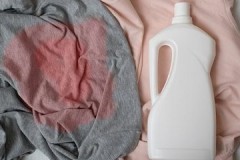Important rules on how to wash kimonos for judo, karate and other martial arts
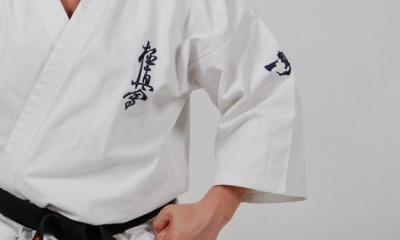 A special type of sportswear, without which it is impossible to imagine training in martial arts - kimono.
A special type of sportswear, without which it is impossible to imagine training in martial arts - kimono.
This lightweight garment made only from natural fabrics does not hinder movement, is comfortable to wear and resistant to wear and tear.
The secrets of proper washing will help to keep the original appearance of clothes longer. How to wash a kimono (for judo, karate) in the washing machine and by hand, we will tell in the article.
Content
Is it possible and how often?
The kimonos are washed frequently. The thing is that clothes saturated with sweat do not smell very pleasant, they look untidy.
Machine wash is carried out no more than once a month (this will help maintain the strength and structure of the fabric).
Washing secrets
 You can wash your kimono either by hand or using the washing machine.
You can wash your kimono either by hand or using the washing machine.
The only thing that, regardless of the choice of washing method, is necessary:
- strictly adhere to the temperature regime (no more than 40C),
- never wash a white and a colored kimono together,
- wring out sportswear as gently as possible.
Failure to follow these simple tips can result in permanent damage to the product.
In the washing machine
To maintain the shape and density of sportswear it is necessary to adhere to a clear sequence of stages of machine washing:
- Before loading clothes into the washing machine drum, get rid of stubborn dirt.
- The required temperature is set: for natural fabrics - no more than 35-40C, for sportswear made of mixed fabrics, a temperature of 40-50C is allowed.
- Powder is poured into a special compartment. For white kimonos, use a liquid detergent in combination with oxygen bleach. For colored sportswear, special powders for colored fabrics are ideal.
- Set the required washing mode: delicate or synthetics.
- Spin - no more than 500 revolutions (if the kimono is sewn from mixed fabrics). For natural materials, machine spinning is prohibited (the function is disabled).
- The prepared clothes are carefully folded and loaded into the washing machine drum (the colored belt is washed separately).
- After washing, the sportswear must be removed immediately and hung to dry.
By hands
A delicate, gentle hand wash will quickly return the kimono to cleanliness and freshness without compromising the shape and color of the product.
Algorithm of actions:
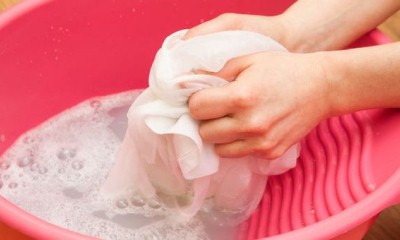 the basin or the bathroom is filled with warm water (temperature not higher than 40C), liquid detergent or powder is added;
the basin or the bathroom is filled with warm water (temperature not higher than 40C), liquid detergent or powder is added;- a dirty kimono is turned inside out and immersed in a soapy solution for several hours;
- after that, with gentle, squeezing movements, the product is washed, paying special attention to the fabric on the collar, cuffs and armpits;
- the washed product is thoroughly rinsed out, two to three times, until the soap solution is completely removed from the fabric;
- the kimono is carefully wrung out and hung out to dry.
Do I need to soak?
If the sportswear is very dirty, then it should be soaked before the main wash.
White sportswear is soaked in soda solution for half an hour (2 tablespoons of soda are dissolved in 10 liters of water).
How do I clean my belt?
An integral part of the costume of a martial arts fighter is a belt. Depending on the skill level, a belt of a certain color is selected.
You should not ignore the care of the belt, since the dirty element of the suit against the background of the snow-white kimono spoils the overall impression of the fighter's appearance.
The easiest way is to wash the white belt. It is placed in a special net (or pillowcase) and loaded into the drum of the washing machine along with the kimono.
Colored belts are washed according to the following pattern:
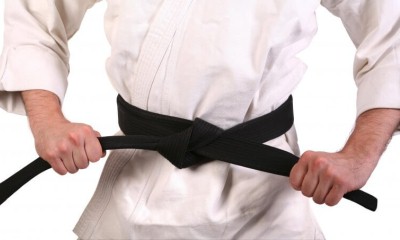 Warm water (no more than 40C) is poured into the basin and powder or liquid detergent for colored fabrics is added.
Warm water (no more than 40C) is poured into the basin and powder or liquid detergent for colored fabrics is added.- The belt is immersed in a soapy solution and left to soak for ten to fifteen minutes.
- After the belt is thoroughly crumpled, and if necessary, treat especially dirty areas with a brush and laundry soap.
- The washed belt is rinsed in clean running water and hung out to dry.
The kimono and the belt are whitened at the same time. This will help to avoid a situation where individual parts of the same martial arts suit differ in shade.
How to remove various stains?
The recipe for getting rid of it depends on the type of stain itself.
- Sweat stains from colored fabric will help to remove the vodka solution (vodka and water are mixed in a 1: 1 ratio). It is enough to soak the dirty thing in the prepared solution and leave for half an hour. After that, the product is washed in the usual way.
- Delete blood stains off white kimono will help hydrogen peroxide. It is enough to abundantly moisten the stain with peroxide, wait until the reaction occurs, remove the pollution with a cotton sponge.
- Get rid of grass stains laundry soap will help. The dirt is rubbed with soap and left for ten to fifteen minutes alone. After that, the clothes are washed in the basic mode.
- To get rid of yellow spots hydrogen peroxide and ammonia will help (mixed in equal proportions). The resulting solution is diluted in water (3-4 tablespoons for 10 liters), in which the kimono is soaked. After an hour, the clothes are washed as usual.
- If a rust stain appears on a white item after washing, lemon will help to bring it out. It is necessary to wrap a slice of lemon in cheesecloth and a paper towel, attach to the stain and press with a hot iron.
How do I get the color back?
You can restore the original whiteness and freshness in the following ways:
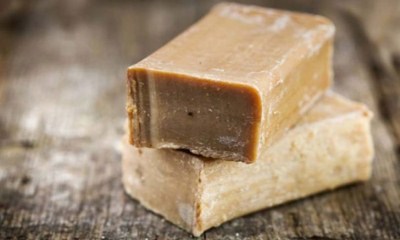 Lather the fabric with laundry soap and leave the clothes alone for two hours. After that, the product can be washed in the usual way.
Lather the fabric with laundry soap and leave the clothes alone for two hours. After that, the product can be washed in the usual way.- Hardwood ash - an excellent folk remedy for bleaching natural cotton and linen.
The ash is poured into a gauze bag and placed in the drum of the washing machine along with dirty clothes.
- Saline solution will help to quickly return the whiteness of the cotton kimono. In 10 liters of oxen dissolve 2 tablespoons of salt, the product is placed in the resulting solution for half an hour. The clothes are then washed in the usual way.
- A solution of hydrogen peroxide (2 tablespoons), ammonia (1 tablespoon) and water (10 liters) helps to cope not only with the gray shade of the washed thing, but also old stains. The kimono is immersed in the prepared solution, left for forty minutes, and then washed by hand or in a machine.
How to remove the smell?
Kimono, saturated with sweat, begins to smell unpleasant. One proven method will help to remove the smell of sweat: it is enough to soak clothes in water with vinegar (for 10 liters of water, 2 tablespoons of vinegar). After soaking, the clothes are thoroughly rinsed and hung out to dry.
The following guidelines will help to minimize the appearance of an unpleasant smell:
- after each workout, the kimono must be removed from the bag and laid out to dry;
- after each workout, clothes must be rinsed under running, cool water;
- drying in the cold will quickly get rid of the unpleasant smell of sweat even without washing.
How to dry?
It is strictly forbidden to dry a kimono made from natural fabrics in an automatic machine, to twist it strongly, to stretch it. From such actions, the fabric stretches and loses its shape, its original appearance.
Basic drying rules:
-
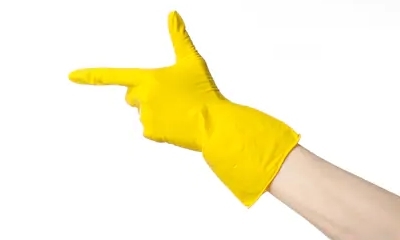 Immediately after machine washing, the clothes must be removed from the drum and hung out to dry. Delay can lead to the formation of creases and folds on the fabric, which will be very difficult to get rid of.
Immediately after machine washing, the clothes must be removed from the drum and hung out to dry. Delay can lead to the formation of creases and folds on the fabric, which will be very difficult to get rid of.Also, a long stay of a wet kimono in the washing machine can cause a very unpleasant, musty odor to appear, which can only be removed by repeated washing.
- Wet clothes are gently shaken and hung out to dry in the open air, in a dark, well-ventilated place.
- It is forbidden to dry the kimono on a battery, near an open fire.
Sportswear made from natural fabrics dries for a long time, so you should be patient and have a second set of replaceable workout uniforms.
Advice
Recommendations for caring for the product are as follows:
- It is strictly forbidden to wash your kimono in hot water. High temperatures may cause the product to shrink.
- A softener added to the water during rinsing can help make the fabric soft and pleasant to the touch.
- Do not soak your kimono in hot water. Under the influence of high temperatures, the dirt eats even more into the fibers of the fabric, and sportswear takes on a gray tint, washed out.
- Regardless of the composition of the fabric, automatic drying is not allowed for kimono.
Conclusion
Regular, proper care of your kimono will help maintain its original appearance for a long time.

